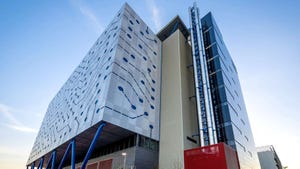Power-Hungry Data Centers Are Gobbling Up Texas Amid AI BoomPower-Hungry Data Centers Are Gobbling Up Texas Amid AI Boom
Texas offers vast tracts of land and a broad supply of cheap energy, but the rapid growth of data centers could significantly deplete both resources.
August 1, 2024

(Bloomberg Markets) -- One business may finally be getting too big for Texas: data centers, those whirring warehouses packed with the electricity-sucking computer servers that power the modern internet and the development of artificial intelligence.
Up until now, the business-friendly state has welcomed their growth, which has been a boon for land values and property taxes. Texas offers vast tracts of land and a broad supply of cheap energy sources, including wind and solar. But the boom in data centers threatens to gobble up quite a bit of both.
Real estate companies backed by private equity firms such as Blackstone, along with tech giants including Microsoft and Alphabet, have snapped up space for AI. The Dallas-Fort Worth area is already the second-biggest US market for leased data center space, according to real estate company CBRE Group.
To keep up with Texas’ soaring energy needs, the state’s grid by 2030 will need to support 152 gigawatts of demand on peak days, almost double what it can currently handle, according to the Electric Reliability Council of Texas (Ercot).
Data centers and crypto miners, which have also flocked to the state, account for a big chunk of that projected demand. Population expansion and hydrogen production plans, as well as oil and gas companies’ push to electrify their operations, are also contributing.
The Texas power grid infamously buckled during a cold snap in 2021, leaving more than 4.5 million homes without power. When Hurricane Beryl slammed into Houston in early July, almost three million customers were left without electricity, including a major data center operated by Lumen Technologies that had to rely on backup generators. It’s the latest reminder of the existing vulnerabilities of Texas’ power system, particularly during extreme weather.
“I am concerned about data centers and the consumption of power as AI computing becomes part of our everyday life,” says state Senator Nathan Johnson, a Democrat whose district includes parts of the Dallas-Fort Worth area. “We have never dealt with electrical growth on this scale and speed.”
“We have never dealt with electrical growth on this scale and speed.”
Even Texas Lieutenant Governor Dan Patrick, a staunch conservative who normally champions pro-business policies and fights government regulation, has expressed some hesitation about the effects of explosive data center growth. Bitcoin miners and data centers “produce very few jobs compared to the incredible demands they place on our grid,” Patrick wrote on the social media platform X.
“We want data centers, but it can’t be the Wild Wild West of data centers and crypto miners crashing our grid and turning the lights off.” In a July 1 statement, he and Governor Greg Abbott said Ercot’s demand growth projections “call for an immediate review of all policies concerning the grid.”
All data centers needing more than 75 megawatts of power – enough to electrify a large factory, a smelter or about 15,000 homes – and vying to come online in less than two years need to get special approval from Ercot under rules put in place in 2022. While Bitcoin miners can shut down their operations when demand and prices get too high, data center operators don’t have that flexibility and can’t offer the same kind of grid-reliability safety check, according to David Naylor, chief executive officer of Rayburn Electric Cooperative, a utility based just outside Dallas in Rockwall.
The Texas grid is particularly vulnerable to strain from 8 p.m. to 9 p.m. when supply from solar energy sources drops off, especially if there’s not enough wind to spin turbines. There’s a 16% chance of a power emergency during those hours in extreme August conditions, according to Ercot, and a 12% chance of rolling blackouts. Meeting demand during the winter has also become more challenging because of extreme weather. Because of the surge of demand from data centers, Texas risks brownouts without new power generation capacity, according to Ram Krishnan, chief operating officer of Emerson Electric Company.
“Texas wants to figure it out because it wants to win the data center investment journey, and I think they will,” says Krishnan, whose company sells software and automation controls to power companies. “But is there a coordinated plan for Texas to figure it out? I haven’t seen it.”
The appetite for data center construction has squeezed other developers out of the market. “We look at the map, and brokers tell us, ‘No, that land went to a data center, and that one did, too,’ ” says Fernando De Leon, the billionaire founder of Leon Capital Group, which develops multifamily and warehouse properties in the Dallas-Fort Worth area. “You’re looking at it and saying, ‘Wow, that’s 20 land parcels that are a thousand acres that all went to data centers, and they’re gonna consume unimaginable swaths of energy’.”
Utility operators say requests from data center developers require the kind of grid capacity that could power entire midsize cities. “The loads are beyond anything we’ve ever seen,” says Matt Mitchell, a spokesperson for Austin Energy, a utility in the capital city. Governor Abbott in early July said he’d seek to double the size of the Texas Energy Fund, to $10 billion. The program provides low-interest loans and grants for the construction of more natural gas plants. Developers have already expressed interest in applying for $39 billion in funding.
The state’s power supply options are far from tapped out. Data centers could find alternative energy sources, including small modular nuclear reactors, according to Pablo Koziner, chief commercial officer of wind and gas turbine manufacturer GE Vernova Inc.
But those won’t be much help on an industrial scale before well into the next decade. “For energy, from now to 2030 is very short-term type of planning,” he says. In the hunt for big blocks of power, “it’s very unlikely that you can solve for that in any other way without some element of gas power.”
More than other states, Texas has been open to expanding gas power. But the average gas plant takes three to four years to complete, while new transmission lines take as many as six, Abbott has said. Data centers, even massive ones, can be built in just a year. “That’s unheard of in terms of grid-planning time scales,” Ercot CEO Pablo Vegas said on a March podcast. By comparison, when Siemens AG decided to electrify part of the production process for a plant in Grand Prairie, Texas, the planning process with its local utility Oncor Electric Delivery Co. stretched for more than 18 months, says Barry Powell, the North American head of Siemens’ electrical products business.
Some data center developers are looking to the Midwest and places such as Reno, Nevada, according to Chris Cornick, head of megaprojects at Ferguson Plc, a distributor of industrial construction materials. Data centers could also locate elsewhere in Texas, including Austin. “I don’t think Dallas is done by any means,” Cornick says. More broadly, “the limitations here are not going to be resources on the data center owner side. The construction market will do our best to keep up. It will be the availability of power.”
About the Author
You May Also Like









